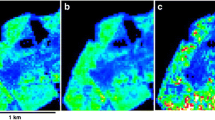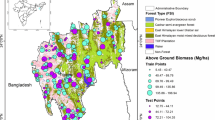Abstract
The ecosystem in northeastern China and the Russian Far East is a hotspot of scientific research into the global carbon balance. Forest aboveground biomass (AGB) is an important component in the land surface carbon cycle. In this study, using forest inventory data and forest distribution data, the AGB was estimated for forest in Daxinganlin in northeastern China by combining charge-coupled device (CCD) data from the Small Satellite for Disaster and Environment Monitoring and Forecast (HJ-1) and Geoscience Laser Altimeter System (GLAS) waveform data from the Ice, Cloud and land Elevation Satellite (ICESat). The forest AGB prediction models were separately developed for different forest types in the research area at GLAS footprint level from GLAS waveform parameters and field survey plot biomass in the Changqing (CQ) Forest Center, which was calculated from forest inventory data. The resulted statistical regression models have a R 2=0.68 for conifer and R 2=0.71 for broadleaf forests. These models were used to estimate biomass for all GLAS footprints of forest located in the study area. All GLAS footprint biomass coupled with various spectral reflectivity parameters and vegetation indices derived from HJ-1 satellite CCD data were used in multiple regression analyses to establish biomass prediction models (R 2=0.55 and R 2=0.52 for needle and broadleaf respectively). Then the models were used to produce a forest AGB map for the whole study area using the HJ-1 data. Biomass data obtained from forest inventory data of the Zhuanglin (ZL) Forest Center were used as independent field measurements to validate the AGB estimated from HJ-1 CCD data (R 2=0.71). About 80% of biomass samples had an error less than 20 t ha−1, and the mean error of all validation samples is 5.74 t ha−1. The pixel-level biomass map was then stratified into different biomass levels to illustrate the AGB spatial distribution pattern in this area. It was found that HJ-1 wide-swath data and GLAS waveform data can be combined to estimate forest biomass with good precision, and the biomass data can be used as input data for future carbon budget analysis.
Similar content being viewed by others
References
Lieth H, Whittaker R H. Primary Productivity of the Biosphere. New York: Springer-Verlag, 1975
Bown S, Lugo A E. Biomass of tropical forest: A new estimate based on forest volumes. Science, 1984, 223: 1290–1293
Kira T, Ona Y, Hosokawa T. Biological production in a warm temperate evergreen Oak forest of Japan. JIBP Synthesis, 1978, 18: 69–82
Fang J Y, Chen A P, Peng C H, et al. Changes in forest biomass carbon storage in China between 1949 and 1998. Science, 2001, 292: 2320–2322
Curran P L, Dungan J L, Gholz H L. Seasonal LAI in slash pine estimated with Landsat TM. Remote Sens Environ, 1992, 39: 3–13
Zheng D, Radenacger J, Chen J, et al. Estimating aboveground biomass using Landsat 7 ETM+ data across a managed landscape in northern Wisconsin USA. Remote Sens Environ, 2004, 93: 402–411
Guo Z H, Peng S L, Wang B S. Estimating forest biomass in western Guangdong using Landsat TM data (in Chinese). Acta Ecol Sin, 2002, 22: 1832–1840
Hame T, Salli A, Andersson K, et al. A new methodology for the estimation of biomass of conifer dominated boreal forest using NOAA AVHRR data. Int J Remote Sens, 1997, 18: 11–32
Phua M H, Saito H. Estimation of biomass of a mountainous tropical forest using Landsat TM data. Can J Remote Sens, 2003, 29: 429–440
Houghton R A, Lawrence K T, Hackler J L, et al. The spatial distribution of forest biomass in the Brazilian Amazon: A comparison of estimates. Glob Change Biol, 2008, 7: 731–746
Dong J, Kaufmann R K, Myneni R B, et al. Remote sensing estimates of boreal and temperate forest woody biomass: Carbon pools, sources, and sinks. Remote Sens Environ, 2003, 84: 393–410
Lu D, Mateus B. Exploring TM image texture and its relationships with biomass estimation in Rondoia, Brazilian Amazon. Acta Amazon, 2005, 35: 261–268
Kasischke E S, Christensen Jr, Haney E M. Modeling of geometric properties of loblolly pine tree and stand characteristics for use in radar backscatter studies. IEEE Trans Geosci Remote Sens, 1994, 32: 800–822
Imhoff M. Theoretical analysis of the effect of forest structure on synthetic aperture radar backscatter and the remote sensing of biomass. IEEE Trans Geosci Remote Sens, 1995, 33: 341–352
Dobson M C, Ulaby F T, Le Toan T, et al. Dependence of radar backscatter on coniferous forest biomass. IEEE Trans Geosci Remote Sens, 1992, 30: 412–415
Ranson K J, Sun G, Lang R H, et al. Mapping of boreal forest biomass from spaceborne synthetic aperture radar. J Geophys Res, 1997, 102: 29599–29610
Sun G, Ranson K J, Kharuk V I. Radiometric slope correction for forest biomass estimation from SAR data in Western Sayani mountains, Siberia. Remote Sens Environ, 2000, 79: 279–287
Harding D J, Carabajal C C. ICESat waveform measurements of within-footprint topographic relief and vegetation vertical structure. Geophys Res Lett, 2005, 32: S10
Lefsky M A, Cohen W B, Acker S A, et al. Lidar remote sensing of the canopy structure and biophysical properties of Douglas-Fir Western Hemlock Forests. Remote Sens Environ, 1999, 70: 339–361
Means J E, Acker S A, Harding D J, et al. Use of large-footprint scanning airborne lidar to estimate forest stand characteristics in the Western Cascades of Oregon. Remote Sens Environ, 1999, 67: 298–308
Lefsky M A, Harding D, Cohen W B, et al. Surface lidar Remote Sensing of basal area and biomass in deciduous forest of Eastern Maryland, USA. Remote Sens Environ, 1999, 67: 83–98
Drake J B, Dubayah R O, Clark D B, et al. Estimation of tropical forest structural characteristics using large-footprint lidar. Remote Sens Environ, 2002, 79: 305–319
Drake J B, Knox R G, Dubayah R O, et al. Above-ground biomass estimation in closed canopy Neotropical forests using lidar remote sensing: Factors affecting the generality of relationships. Glob Ecol Biogeogr, 2003, 12: 147–159
Zhou Y L. China Daxinganlin Vegetation (in Chinese). Beijing: Science Press, 1991
Feng Z W, Wang X K. Biomass and Productivity of Chinese Forest Ecosystem (in Chinese). Beijing: Science Press, 1999
Xu Z B, Dai H C. Daxinganling main forest types of biological production (in Chinese). Chin J Ecol, 1988, 7(Suppl): 49–54
Sun G, Ranson K J, Kimes D S, et al. Forest vertical structure from GLAS: An evaluation using LVIS and SRTM data. Remote Sens Environ, 2008, 112: 107–117
Author information
Authors and Affiliations
Corresponding author
Rights and permissions
About this article
Cite this article
Guo, Z., Chi, H. & Sun, G. Estimating forest aboveground biomass using HJ-1 Satellite CCD and ICESat GLAS waveform data. Sci. China Earth Sci. 53 (Suppl 1), 16–25 (2010). https://doi.org/10.1007/s11430-010-4128-3
Received:
Accepted:
Published:
Issue Date:
DOI: https://doi.org/10.1007/s11430-010-4128-3




